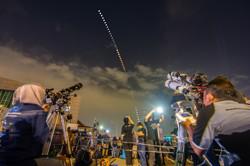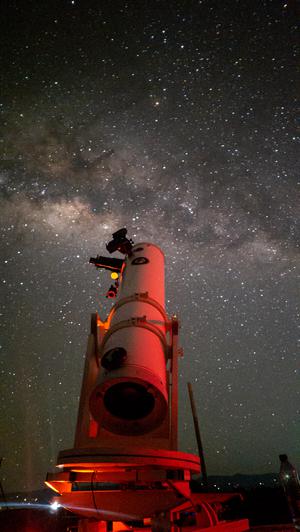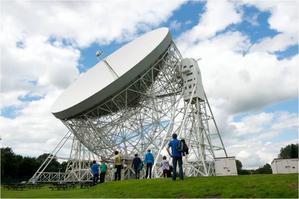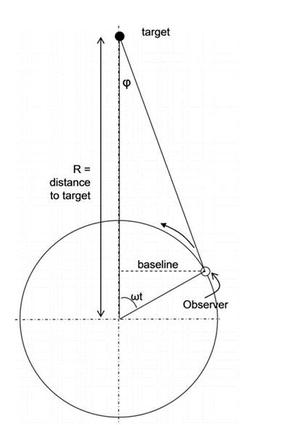Glossary term: 望遠鏡
Description: 望遠鏡是一種收集遙遠物體的光子(可見光或其他波段)並向觀察者提供有關信息(如圖像)的裝置。早期的望遠鏡(從 17 世紀初開始)使用透鏡作為光學元件(如折射望遠鏡)。透鏡的製作尺寸有上限,因此為了用更大的望遠鏡更細緻地觀察較暗的物體,人們改用鏡子(見反射望遠鏡)來聚焦光線。最大的光學望遠鏡就是反射望遠鏡。在20 世紀,人們發明瞭研究電磁波譜其他波段的望遠鏡,因此現在有了射電望遠鏡、紅外望遠鏡、X 射線望遠鏡等。由於天體很闇弱,天文學家傾向於建造大口徑望遠鏡,以收集更多光線,達到更精細的角分辨率。
Related Terms:
See this term in other languages
Term and definition status: The original definition of this term in English have been approved by a research astronomer and a teacher The translation of this term and its definition is still awaiting approval
This is an automated transliteration of the simplified Chinese translation of this term
The OAE Multilingual Glossary is a project of the IAU Office of Astronomy for Education (OAE) in collaboration with the IAU Office of Astronomy Outreach (OAO). The terms and definitions were chosen, written and reviewed by a collective effort from the OAE, the OAE Centers and Nodes, the OAE National Astronomy Education Coordinators (NAECs) and other volunteers. You can find a full list of credits here. All glossary terms and their definitions are released under a Creative Commons CC BY-4.0 license and should be credited to "IAU OAE".
If you notice a factual or translation error in this glossary term or definition then please get in touch.
Related Media
我們之間的日食,作者穆罕默德·雷漢,印度尼西亞
Credit: 穆罕默德·雷漢/國際天文學聯合會教育辦公室
License: CC-BY-4.0 Creative Commons 姓名標示 4.0 國際 (CC BY 4.0) icons
了解夜空
Credit: Juan Pablo Botero Londoño/IAU OAE (CC BY 4.0)
License: CC-BY-4.0 Creative Commons 姓名標示 4.0 國際 (CC BY 4.0) icons
Related Activities
Big Telescopes: Gravity
astroEDU educational activity (links to astroEDU website) Description: Observing what gravity is doing to the Universe
License: CC-BY-4.0 Creative Commons 姓名標示 4.0 國際 (CC BY 4.0) icons
Tags:
Experiment
Age Ranges:
12-14
, 14-16
Education Level:
Middle School
, Secondary
Areas of Learning:
Guided-discovery learning
, Interactive Lecture
, Modelling
Costs:
High Cost
Duration:
1 hour 30 mins
Group Size:
Group
Skills:
Analysing and interpreting data
, Asking questions
, Developing and using models
, Planning and carrying out investigations
The 4-Point Backyard Diurnal Parallax Method
astroEDU educational activity (links to astroEDU website) Description: Measure the distance to an asteroid with a novel technique
License: CC-BY-4.0 Creative Commons 姓名標示 4.0 國際 (CC BY 4.0) icons
Tags:
Hands-on
, Measurement
, Distances
, CCD imaging
, astrometry
Age Ranges:
16-19
, 19+
Education Level:
Informal
, Secondary
, University
Areas of Learning:
Guided-discovery learning
, Project-based learning
Costs:
High Cost
Duration:
several days
Group Size:
Group
Skills:
Analysing and interpreting data
, Asking questions
, Communicating information
, Constructing explanations
, Planning and carrying out investigations
, Using mathematics and computational thinking
How do telescopes work?
astroEDU educational activity (links to astroEDU website) Description: Let's discover telescopes and experiment simple optics
License: CC-BY-4.0 Creative Commons 姓名標示 4.0 國際 (CC BY 4.0) icons
Age Ranges:
10-12
Education Level:
Primary
Areas of Learning:
Guided-discovery learning
, Historical focussed activity
, Observation based
Costs:
Medium Cost
Duration:
1 hour
Group Size:
Group
Skills:
Asking questions













